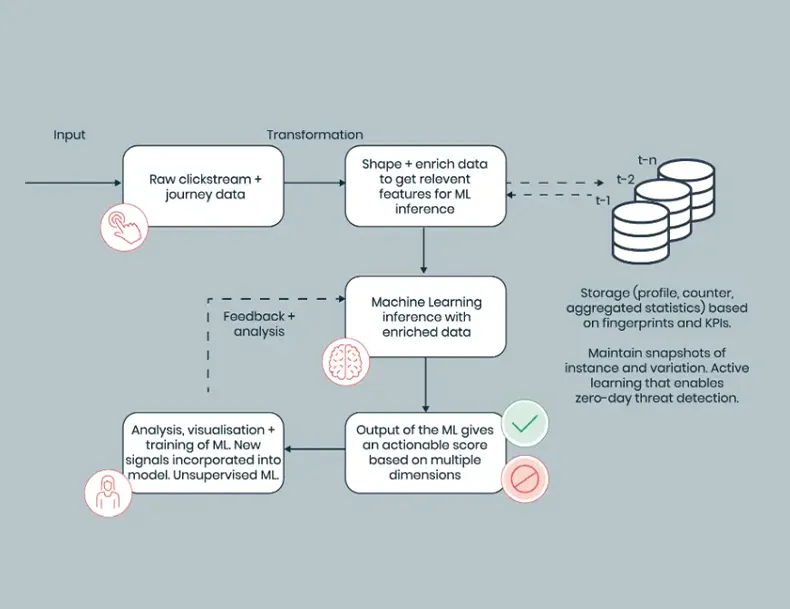What does machine learning in fraud prevention look like?

This article is taken from our eBook – Understanding machine learning in fraud prevention. To read the full book, see here.
Complex rules-based fraud prevention is no match for the sophisticated fraud stealing ad spend today. Well funded fraudsters adapt and innovate, like any successful business, when faced with new threats to their profitability. So in this arms race against fraud, what does machine learning look like?
There are 4 essential elements driving machine learning success:
- Infrastructure: From a technological standpoint, ML needs a sophisticated engine that can scale with fluctuations in volume, that can efficiently process high volumes of data, both batch and streaming and deliver actionable insights in near real-time
- The human element: Contrary to popular belief, machine learning isn’t self-sufficient. Skilled analysts need to define problems, identify appropriate technology, prepare the data, store it in task-specific locations, train machine learning models, manage and continuously verify models over time. The role of human is integral to successful machine learning
- Data: As our head of Data Science Raigon Jolly says, “rubbish in, rubbish out”. Data management involves rigorous preparation, labelling, and task-specific storage to ensure that the right data can be retrieved for specific functions. Types of data include behavioural patterns, location data, transactional data, device and network data
- Algorithms: It goes without saying that algorithms are an essential ingredient to machine learning but you would be surprised by the number of folks that say they have machine learning capabilities without them. In fraud prevention, machine learning needs to use computationally efficient models – deploying machine learning for tasks that can be reliably resolved with rules, only serves to slow everything down. Machine learning should be additive, not the exclusive means of fraud prevention
TrafficGuard combines models and techniques to build unique, contextual knowledge about digital activity and user behaviour that leads to the most advanced fraud protection.

Every click, conversion and event is received by TrafficGuard along with hundreds of data points that characterise that transaction, like source IP, device, operating system, time of day etc. The transaction’s record is saved in the appropriate location and enriched by all of the other data in TrafficGuard – all the other times a device has been seen, other transactions on the same campaign, across campaigns by the same supply source etc.
With the context of that specific transaction and the trillions of data points TrafficGuard has been built on, it can confidently say whether a transaction is valid or invalid.
Machine learning models are used to validate transactions based on enriched data. In the case of zero-day threats, deep learning is particularly useful. Deep learning is the function of layers of neural networks capable of processing very large and high dimensional data sets to uncover latent relationships in data. TrafficGuard’s neural networks ingest raw, unlabeled data to recognise patterns, cluster transactions together and assist in classification. Our neural networks are an unsupervised machine learning technique, making them critical in the fight against zero-day ad fraud because they don’t rely on the prior classification of fraud types. Neural networks also support other machine learning algorithms for reinforcement and regression.
Deep learning models validate transactions and the valid/invalid classification then gets fed back into the data to help future determinations of validity.
In Summary
There is no one correct way to apply machine learning and many businesses with varying levels of expertise are jumping in, in order to not be left behind. Getting all of the elements of machine learning performing reliably takes time and dedicated and experienced data science and dev ops teams. A company at the start of its machine learning journey should be treated cautiously.
At TrafficGuard, machine learning enables our award-winning fraud prevention to:
- Reduce false positives with precision fraud mitigation
- Reduce false negatives to catch fraud that other fraud vendors or measurement platforms miss
- Mitigate fraud from known and unknown tactics
- Drive our relentless pursuit to prevent fraud at the earliest possible opportunity, supporting our efforts to stop fraudsters from getting paid
Get started - it's free
You can set up a TrafficGuard account in minutes, so we’ll be protecting your campaigns before you can say ‘sky-high ROI’.
Subscribe
Subscribe now to get all the latest news and insights on digital advertising, machine learning and ad fraud.








